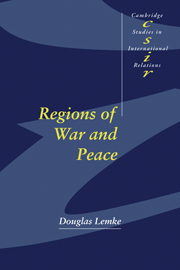Book contents
- Frontmatter
- Contents
- Acknowledgments
- 1 Introduction
- 2 Theoretical origins
- 3 Theoretical revision: the multiple hierarchy model
- 4 Identifying local hierarchies and measuring key variables
- 5 Empirical investigations
- 6 Further investigations I: great power interference?
- 7 Further investigations II: an African (interstate) Peace?
- 8 Conclusions, implications and directions for continued research
- Appendix: Replication with Correlates of War capabilities data
- References
- Index
- CAMBRIDGE STUDIES IN INTERNATIONAL RELATIONS
8 - Conclusions, implications and directions for continued research
Published online by Cambridge University Press: 22 September 2009
- Frontmatter
- Contents
- Acknowledgments
- 1 Introduction
- 2 Theoretical origins
- 3 Theoretical revision: the multiple hierarchy model
- 4 Identifying local hierarchies and measuring key variables
- 5 Empirical investigations
- 6 Further investigations I: great power interference?
- 7 Further investigations II: an African (interstate) Peace?
- 8 Conclusions, implications and directions for continued research
- Appendix: Replication with Correlates of War capabilities data
- References
- Index
- CAMBRIDGE STUDIES IN INTERNATIONAL RELATIONS
Summary
The need for a weaving together of the strands of this book seems greater than is the case with most volumes. The reason for this is that I address three interrelated tasks in this book. The first is an evaluation of the multiple hierarchy model extension of power transition theory to minor power regions, necessitating consideration of whether such an extension is justifiable. The second task is empirical identification of what a regional sub-system is. Unless regional sub-systems of the international system are objectively identified, extensions of great power theories to the minor power level cannot be empirically evaluated. The final task is an exploration of possible sources of persistent cross-regional variation in the relationships between power parity, status quo evaluations, and war onset. All three of these tasks have been accomplished, at least partially, in the preceding chapters. However, my book offers only a first perspective on each, and more can clearly be done to address all three. The third section below lays out steps likely to help any effort to move beyond my preliminary achievements.
Summary
Power transition theory was created to account for great power interactions. No clearer statement of this is needed than Organski and Kugler's own recognition that their work could:
not claim to establish connections between changes in the international power structure and the outbreak of wars among small nations, or among large and small nations; nor do the models explain colonial wars … The hypotheses in question can be tested fairly only if we locate conflicts whose outcomes will affect the very structure and operation of the international system. (1980: 45)
- Type
- Chapter
- Information
- Regions of War and Peace , pp. 195 - 206Publisher: Cambridge University PressPrint publication year: 2002



